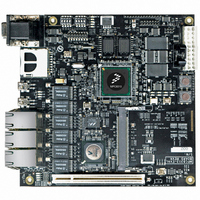MPC8313E-RDB Freescale Semiconductor, MPC8313E-RDB Datasheet - Page 27

MPC8313E-RDB
Manufacturer Part Number
MPC8313E-RDB
Description
BOARD PROCESSOR
Manufacturer
Freescale Semiconductor
Series
PowerQUICC II™ PROr
Type
MCUr
Datasheets
1.MPC8313CZQAFFB.pdf
(100 pages)
2.MPC8313E-RDBB.pdf
(52 pages)
3.MPC8313E-RDBB.pdf
(2 pages)
Specifications of MPC8313E-RDB
Contents
Reference Design Board, Software and Documentation
Termination Type
SMD
Supply Voltage Max
1.05V
Tool / Board Applications
Wired Connectivity-LIN, CAN, Ethernet, USB
Mcu Supported Families
POWERQUICC II PRO
Rohs Compliant
Yes
Filter Terminals
SMD
Silicon Manufacturer
Freescale
Silicon Core Number
MPC83xx
Kit Application Type
Communication & Networking
Application Sub Type
Ethernet
Core Architecture
Power Architecture
Silicon Family Name
PowerQUICC II PRO
For Use With/related Products
MPC8313E
Lead Free Status / RoHS Status
Lead free / RoHS Compliant
the signal LB_POR_CFG_BOOT_ECC_DIS (TSEC1_MDC) during power on reset (REVB and REVC
only. REVAx is a reserved switch (RSVD0)). REV1 represents bit 1 of the revision number. Together with
REV0 (implemented by resistor option; the default is 0), REV[0..1] shows the revision number, which is
01 by default. The values can be read from a buffer on the RDB. BOOT1 selects the boot device on the
RDB. By default, BOOT1 is set, so chip-select 0 (CS0) is connected to the NOR Flash. CS1 is connected
to the NAND Flash memory. If BOOT1 is cleared, CS0 is connected to NAND Flash memory, and CS1 is
connected to NOR Flash memory.
3.12
Eight programmable LEDs give status indication and debug information.
An 8-bit write register on the RDB turns the LEDs on and off. The LEDs are arranged so that the most
significant bit represents LED0 and least significant bit represents LED7; that is, LED[0..7]. A write of
0x00 turns on all LEDs, and 0xFF turns off all LEDs.
4
The eTSEC1 RGMII, ULPI USB, and IEEE 1588 signals are multiplexed on the MPC8313E. The
MPC8313E RDB supports switching among the three interfaces using micro-jumpers (REVA boards) or
resistor options (REVA1 or later boards).
Freescale Semiconductor
Micro-Jumper/Resistor Options for eTSEC1
RDB Programmable LEDs
For IEEE 1588 support, use the same setting as for the eTSEC1 RGMII. In
this case, a 50 MHz clock would be provided for the IEEE 1588 TMR_CLK
pin.
PowerQUICC™ MPC8313E Reference Design Board (RDB), Rev. 4
LED4
(Green)
LED0
(Red)
Figure 29. Programmable LEDs
LED1
(Yellow)
LED5
(Green)
NOTE
LED2
(Green)
LED6
(Green)
LED3
(Green)
LED7/LCD_EN
(Green)
Micro-Jumper/Resistor Options for eTSEC1
Figure 29
shows the diagram.
27











